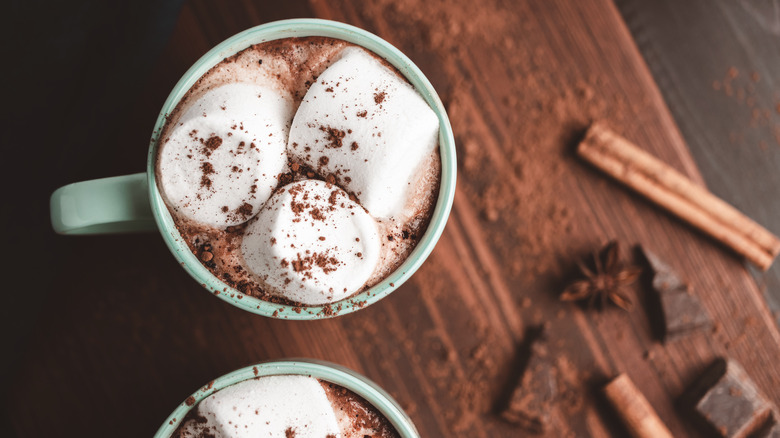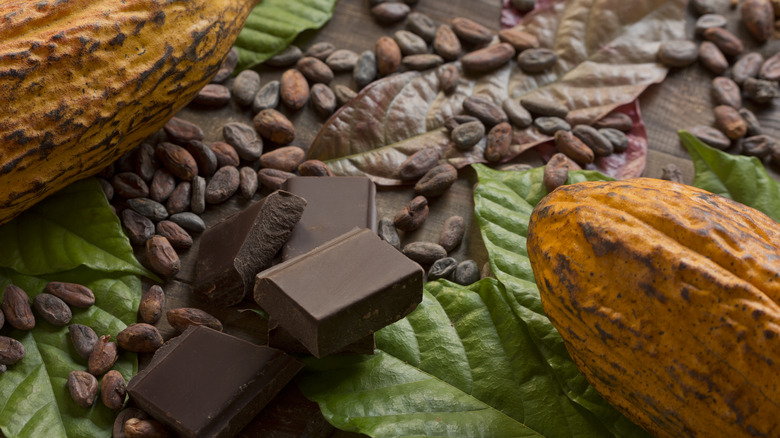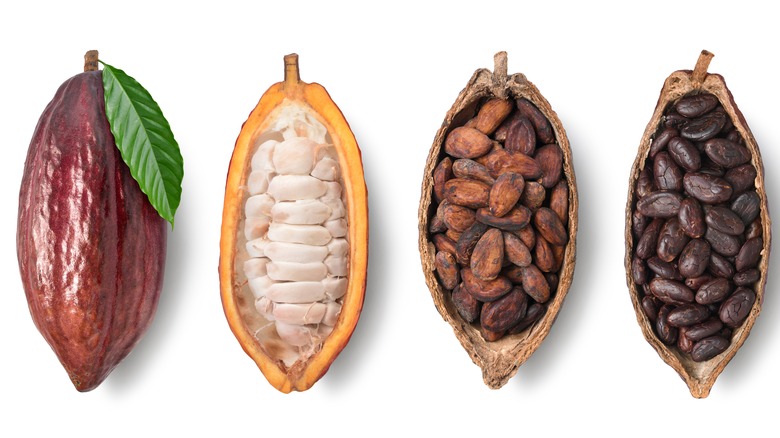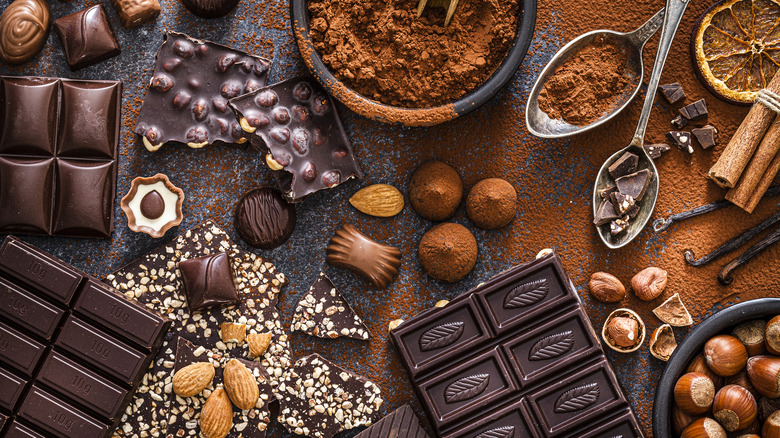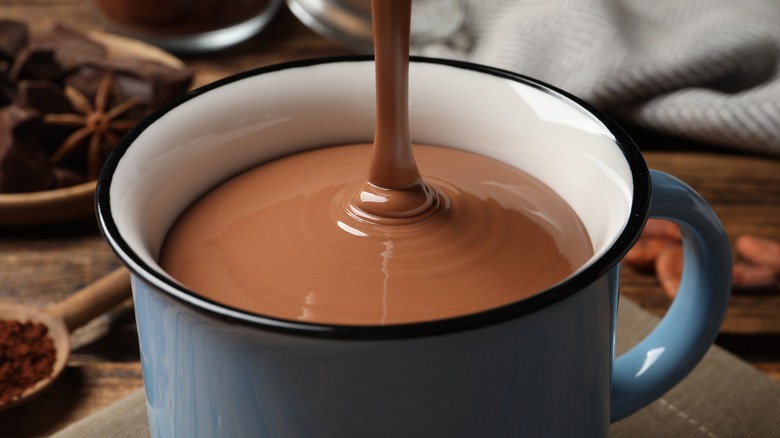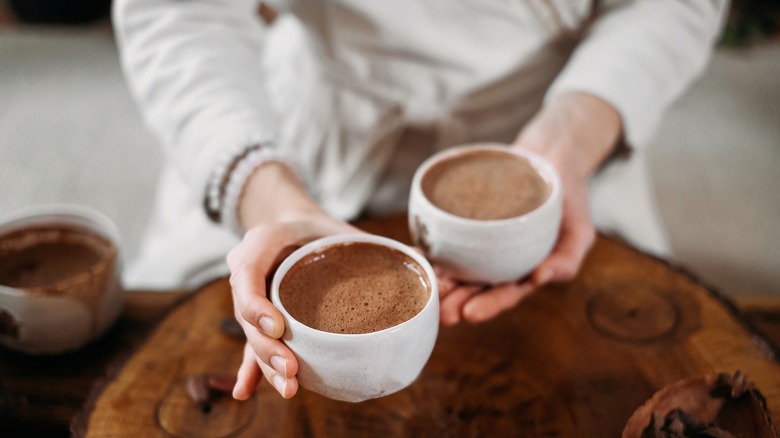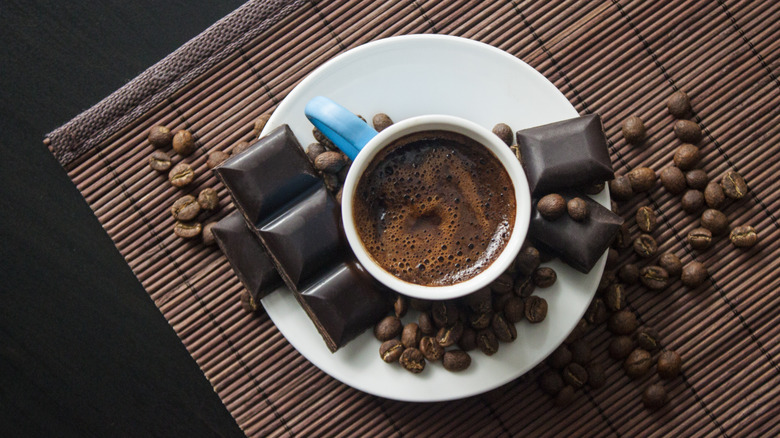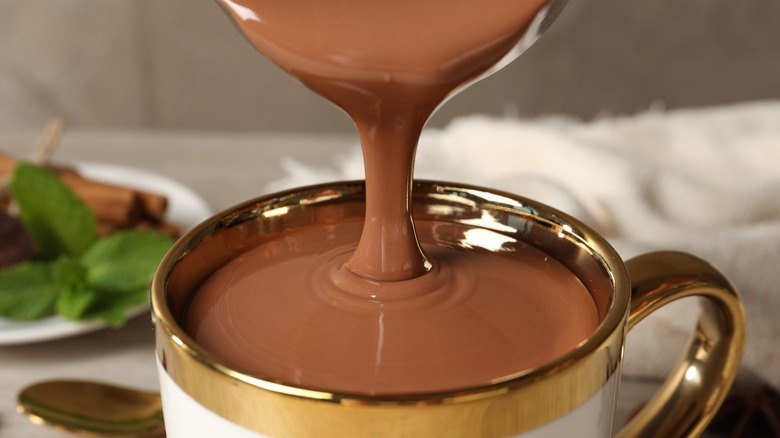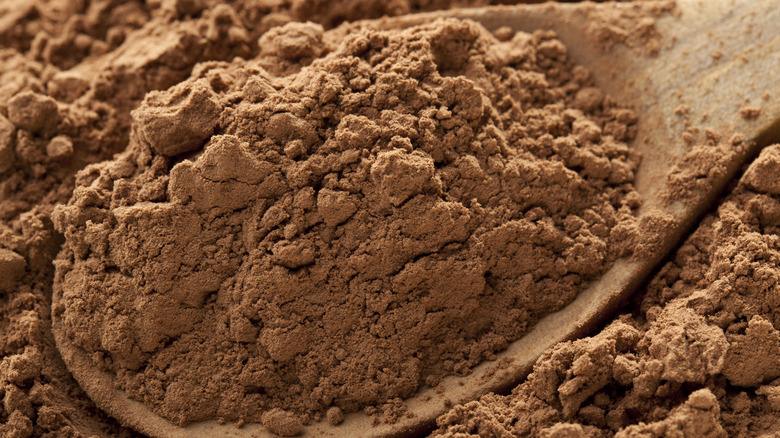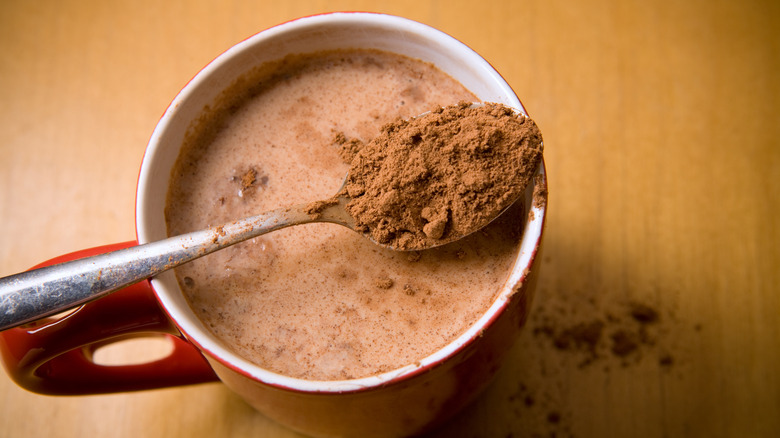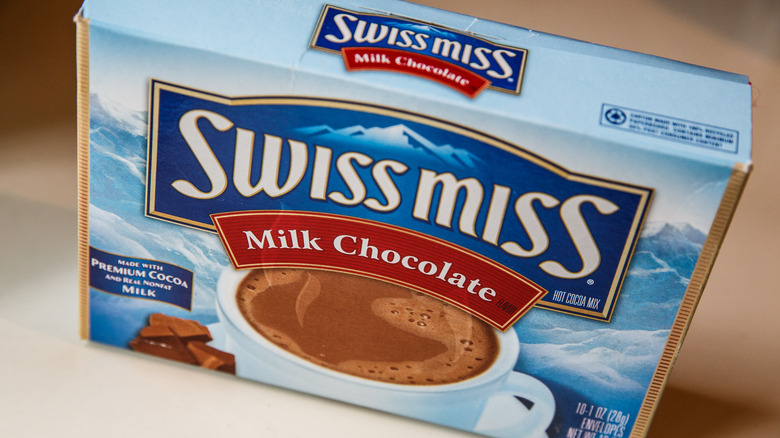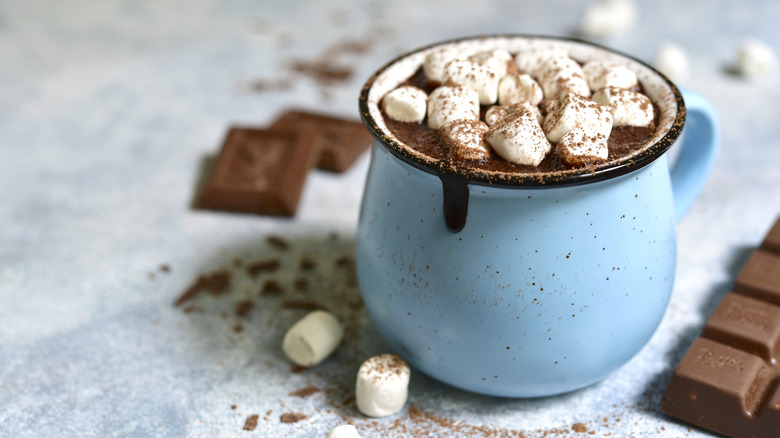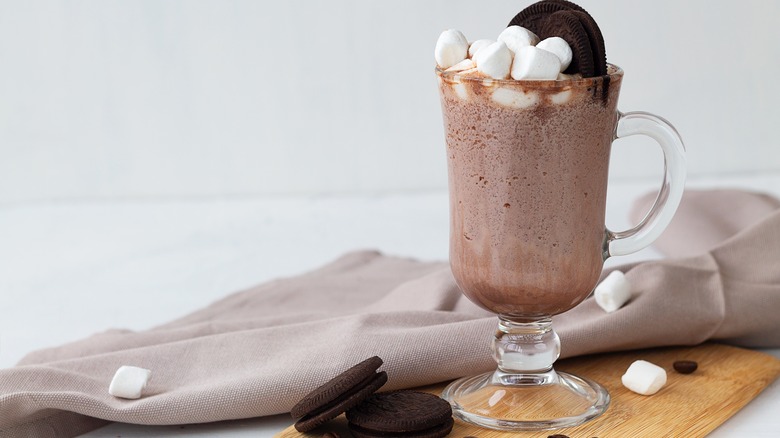The Rich History Of Drinking Hot Chocolate
Water or milk? Chocolate or cocoa powder? Marshmallows or whipped cream? Hot chocolate as we know it today can be prepared many different ways, with a slew of various mix-ins and toppings. It's sweet, creamy, and comforting — but it also couldn't be more different from the drinking chocolate that was revered by the ancient Olmec civilization. Before hot chocolate was sweetened with sugar and made creamy with milk, it was still pourable and frothy but bitter — and the cacao tree that grew the fruit needed to make drinking chocolate certainly didn't grow in Belgium, Switzerland, or Western Africa. So how did these now world-renowned chocolate producing places learn about it in the first place?
The history of how hot chocolate evolved from a bitter drink with alleged aphrodisiac properties and health benefits to a popular winter beverage sold in instant packets stretches back thousands of years. Hot chocolate's worldwide success involved ancient civilizations, colonizers, culinary inventors, and more.
What is chocolate anyway?
Before we dive into the ancient history of drinking chocolate, it's important to first understand the basic ingredients used to make chocolate today. Bars of chocolate are made from a combination of chocolate liquor, cocoa butter, sugar, and some sort of emulsifier to blend everything together. Milk chocolate also contains milk to make it extra creamy, go figure. Don't let the name fool you though — chocolate liquor isn't alcoholic. It's a liquid that's made by fermenting the center of the cocoa bean (called the nib). Once fermented, the nib is roasted and ground until pourable in consistency.
Sounds like a certain cold weather beverage, doesn't it? As it turns out, the chocolate liquor that is stirred into your favorite milk and dark chocolates is actually quite similar to the drinking chocolate that was first consumed by the ancient Olmec, Maya, and Aztec populations beginning more than 3,000 years ago.
The world's first chocolate wasn't served in bar form
The sweet and creamy chocolate we consume in bar form today is a far cry from the chocolate that was first prepared in ancient Mesoamerica. During Olmec times, there were no shelf-stable Hershey's-type bars conveniently on hand for daily snacking. But it's believed that the Olmec first began preparing chocolate around 1500 B.C., and that they followed a process similar to how chocolate liquor is made today.
That said, Hayes Lavis, a cultural arts curator for the Smithsonian's National Museum of the American Indian, explained in an interview with Smithsonian Magazine that archaeologists aren't completely certain how the Olmec first prepared drinking chocolate — or if they were even the first culture to do so — because no written record was left by this civilization. However, it's likely that the Olmec dried, fermented, roasted, and ground cacao beans to create drinkable chocolate.
The Olmec apparently passed their knowledge onto the Maya and Aztecs, who developed their own methods for preparing and drinking chocolate. The drinking chocolate enjoyed by these later civilizations was incredibly bitter and flavored with spices, such as chili and vanilla, according to Meredith L. Dreiss and Sharon Greenhill's "Chocolate: Pathway to the Gods" (via Metropolitan College's Gastronomy Blog). To make the chocolate easier to drink, boiling water was stirred into it. The Olmec also preferred their chocolate to have some froth on top.
The Maya considered chocolate the food of the gods
The Maya believed that cacao was discovered by the gods, hidden in a mountain. After humans were created from maize, the Sovereign Plumed Serpent god is said to have gifted them cacao, according to The Journal of Nutrition's "Food of the Gods: Cure for Humanity? A Cultural History of the Medicinal and Ritual Use of Chocolate." The Maya revered the substance to the extent that they held an annual festival dedicated to the god of cacao. It took many people to properly harvest and transform cocoa beans into drinking chocolate, and written records tell us that drinking chocolate was consumed on a regular basis by members of all social classes.
However, it was also served during special celebrations and ceremonies. Explaining that evidence was found in parts of Guatemala that women could even be required "to make the cacao and prove that she could make it with the proper froth" prior to getting married, Hayes Lavis told Smithsonian Magazine in part, "It's one of the few food crops that was used as a dowry."
The Aztecs drank chocolate as an aphrodisiac
Called xocoatl (meaning "bitter water"), Aztec drinking chocolate was prepared similarly to the Olmec and Maya versions. The ground chocolate was mixed with water or wine and spices, but it was commonly served cold. Unlike in Maya culture, where everyone drank chocolate, the Aztecs largely limited its availability to nobles, military officers, and equally important men. Meanwhile, women and children weren't allowed to drink chocolate since it was considered an intoxicant.
Many of the most outrageous legends surrounding hot chocolate stem from the Aztec period. The most popular being that Emperor Montezuma II drank 50 cups of chocolate per day, claiming that it energized him and had aphrodisiac properties. "I don't think any living person could drink 50 cups of cacao," Hayes Lavis told Smithsonian Magazine. Montezuma might not have actually drank 50 cups per day, but this shows just how highly the Aztecs regarded the beverage.
Spanish conquistadors brought sipping chocolate to Europe
It's unclear how or when exactly drinking chocolate wound up in the most fashionable courts of Europe in the 1500s, but most agree that the Spanish conquistadors were responsible for it. Some believe Christopher Columbus brought cacao beans back to Spain; others say Montezuma served Hernán Cortés drinking chocolate and that's how it wound up in Europe. Perhaps drinking chocolate was made for the Spanish court by a group of Maya who were taken from their homeland. No one knows for sure how the rich beverage ended up in Spain, but pretty soon all of Europe was drinking it — or was desperate to try it. Spanish forces returned to Mexico and South America to ensure a continual supply of cacao was sent back to the Old World, and indigenous peoples were often enslaved in both here and in Western Africa to provide the cacao plantations with cheap labor.
European colonialism is also responsible for the addition of sugar to the once-bitter chocolate, which transformed the drink into the hot chocolate we happily sip today. Sugar was another popular commodity during the Colonial Era, produced in the Caribbean using slave labor, per Harvard's ReVista.
English chocolate houses fueled the hot chocolate craze
Hot chocolate remained a luxury good for quite some time. Although cacao beans were regularly shipped to Europe, the production process was still fairly lengthy, which kept the prices high and the clientele elite. In England, hot chocolate became one of the most fashionable drinks of the 17th and 18th centuries. Chocolate houses sprang up throughout London and effectively acted as gentlemen's clubs. They were a place to meet with friends, make social connections, discuss politics, gamble, and let loose, according to historian Dr. Matthew Green's book "London: A Travel Guide Through Time" (via Gastro Obscura). These spots were also fairly expensive, and therefore only wealthy men could afford to frequent chocolate houses.
Hot chocolate's popularity among the upper European classes waned in the late 18th century. Industrialization made chocolate quicker and easier to produce; once the price of chocolate dropped and it was no longer considered a luxury good, chocolate houses lost their prestige over time.
European colonists brought drinking chocolate to America
Hot chocolate made its way back across the pond the same way it first arrived in Europe — thanks to colonialism. It's unclear when colonists in the New World first began making hot chocolate like their European forefathers, but by the time the Revolutionary War started, chocolate was regularly being shipped from England to its American colonies. According to the Natural History Museum of Utah, the Delaware River Bay Valley — which was still under Great Britain's control — received at least a quarter million pounds of chocolate between 1765 and 1773 alone.
In the American colonies, hot chocolate was sweetened with sugar and served warm, thick, and rich. However, this hot chocolate was made much less sweet than how it's prepared today, with the addition of spices like cinnamon, nutmeg, vanilla, and orange peel. Anyone could drink hot chocolate in colonial America, even children. Many homes, then, owned a chocolate pot specifically for making hot chocolate, per Vice's Munchies. Back then, chocolate was sold in large bricks; a small amount of chocolate had to be shaved off the larger brick and then stirred into a hot liquid (typically milk). That's why chocolate pots came fitted with a stirrer.
American colonists also loved hot chocolate for its supposed health benefits — such as being an alleged smallpox cure, as Benjamin Franklin himself touted — as much as the taste. As chocolate historian David Borghesani told Vice's Munchies, "It didn't take long for people to get that sweet tooth."
The invention of cocoa powder changed hot chocolate forever
First came cacao, then drinking chocolate, and finally cocoa powder. Cocoa powder was invented by the Dutch chemist Coenraad Johannes van Houten. He patented his method for removing cocoa butter from cacao in 1828. Cocoa butter is the fat of the cocoa bean; it's used in the chocolate-making process, but you might also have spied it on the ingredients list of your favorite body lotion. Once most of the cocoa butter is taken from processed cacao (about 73% winds up being removed in total), the resulting dry cake of chocolate is ground into a fine powder, per Cornell University Library's "Chocolate: Food of the Gods" exhibition. The invention of cocoa powder paved the way for the creation of chocolate bars and eventually hot cocoa.
Nowadays, there are eight main types of cocoa powder on the market. Van Houten is also credited for inventing Dutched cocoa powder, which has a deeper flavor than standard cocoa powder due to being alkalinized with a potassium carbonate wash.
Hot chocolate vs hot cocoa
Yes, there's a difference between hot chocolate and hot cocoa. You might have grown up using the two terms interchangeably, but they're actually separate beverages. Modern hot chocolate is the descendant of the bitter drinking chocolate consumed by the Maya and Aztec. It's made with melted chocolate from a bar, sugar, and milk. Hot chocolate is rich, thick, and dark in color. Although it's sweetened with sugar, it's not overly sweet.
Hot cocoa also features milk and sugar, but cocoa powder is used to impart a chocolatey flavor instead of actual chocolate. It's lighter in color and thinner in consistency. It's not as rich as hot chocolate, but it's much sweeter. Cocoa powder lasts longer than regular chocolate, which makes it a good option to keep on hand for making homemade hot cocoa. Although cocoa powder was invented in the 1820s, it took more than a century for instant hot cocoa to come on the scene.
Instant hot cocoa was a byproduct of the Korean War
In 1961, Sanna Dairies began selling the instant hot cocoa mix that would later be called Swiss Miss. What made the hot cocoa stand out from the crowd was that it didn't require the addition of milk, only boiling water. This type of instant hot cocoa was the brainchild of Charles Sanna, chief engineer at Sanna Dairies in Wisconsin, as reported by The Washington Post. The end of the Korean War marked the conclusion of the company's contract with the U.S. military; unfortunately, it also left Sanna Dairies with a surplus of powdered coffee creamer on its hands. The perishable product needed to be sold — and fast.
Sanna eventually perfected his recipe for instant hot cocoa using the company's excess powdered coffee creamer, cocoa powder, sugar, and vanilla. All you had to do was add hot water. Needless to say, instant hot cocoa was a hit with Americans. It's estimated that 50 million boxes of Swiss Miss alone are sold per year.
Marshmallows were added to hot chocolate as a marketing strategy
Hot chocolate without marshmallows is like eating a peanut butter sandwich minus the jelly. It still tastes good, but it's not the same. Marshmallows were paired with hot chocolate starting in 1917. The company Angelus Marshmallows needed more people to buy its product. Marshmallows were originally made by hand, but once the process became industrialized, they were ready to be sold en masse. So, Angelus Marshmallows commissioned a recipe booklet to showcase the many ways to prepare and eat marshmallows, per Smithsonian Magazine. One popular flavor pairing from the booklet that Americans still eat today is sweet potatoes and marshmallows. The other? Marshmallow-topped hot chocolate.
Consumers loved how the sticky sweet marshmallows melted into the hot chocolate and made it even more flavorful. Topping hot chocolate with marshmallows is now common practice. Many instant hot cocoa mixes even contain dehydrated marshmallows so that hot chocolate lovers can get the full drinking experience just by adding hot water.
Hot chocolate continues to evolve
Adding sugar to drinking chocolate was the first of many changes to the beverage that the ancient Olmec, Maya, and Aztec prized so highly. In recent years, instant hot cocoa packets have invaded seemingly every home in America, and you can forget about serving anyone a warm mug of the stuff if there's not a pile of marshmallows on top. And marshmallows are just the tip of the iceberg when it comes to all the hot chocolate toppings and flavor combinations you can create. Caramel sauce, crushed cookies, whipped cream, donuts, stroopwafels, Irish cream, Cointreau — the list of mix-ins and toppings goes on and on.
Even more delicious is the creation of frozen hot chocolate. Places like Serendipity3 in New York City began serving the hot drink as a cold treat nearly 70 years ago and have since gained a cult following thanks to rave reviews from the likes of Jackie Kennedy and Oprah Winfrey. So, what does the future hold in store for hot chocolate? You decide. Start with your favorite hot chocolate recipe and get creative. When it comes to drinking chocolate, the options are limitless.
